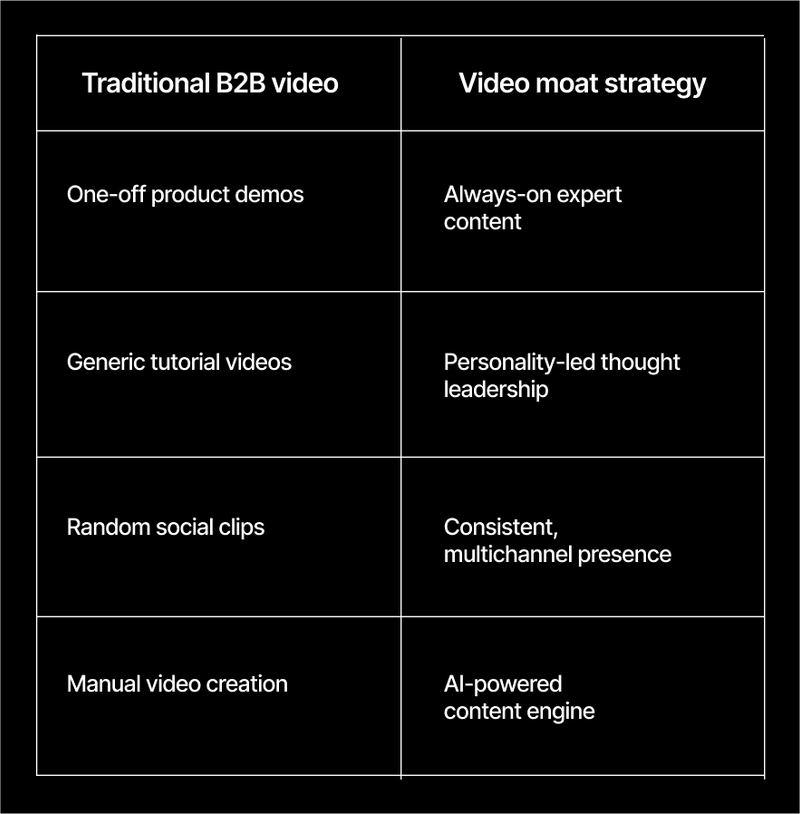The B2B Content Engine Starts with Video (Here’s How to Win in 2025)

Table of Contents
Maximize Your Marketing ROI
Join 10,000 other marketers already getting the best tips on running engaging events that boost pipeline and create raving fans.
Research from the Ehrenberg-Bass Institute shows that 95% of your buyers aren't actually shopping. And in a sea of AI noise, they might not even know you exist.
If you're not building a video moat around your brand, you're leaving the door wide open for competitors who are. Here’s how to make video work for you.
Don't let AI content drown out your brand.
Create your video moat with Goldcast's proven playbook.
The state of B2B video in 2025: what's changed?
Machines can churn out endless blog posts and social copy—but they can't replace the connection that comes from real insiders spilling their secrets.
In 2025, LinkedIn is pushing video harder than ever and YouTube has cemented its position as the #2 search engine globally.
Why? Because in a world of AI-generated fluff, nothing builds trust like experts on screen.
“Your experts are goldmines of knowledge, but they’re often tied up with different responsibilities and don’t necessarily have the bandwidth to support content creation,” says Kelly Cheng, Goldcast CMO. “The perfect opportunity to tap into them is with long-form videos.”
Here's the reality check:
- A flood of AI-generated content has made personality-driven video more valuable than ever.
- 73% of B2B buyers watch video content before reaching out to sales (Goldcast data, 2024).
- On LinkedIn, video content averages a 5.6% engagement rate compared to 4% for text-only.
If you're not all-in on video, you're already behind.
But the good news is, there’s still time to catch-up. B2B buyers aren’t saturated with video content the same way B2C consumers are. But the clock is ticking.
The smartest players in the game? They're betting big on video—and it's paying off.
➡️Not sure where to start? Get our free guide to the latest best practices in B2B video marketing.
3 ways video is reshaping B2B marketing
In 2025, B2B brands winning with video are focused on execution—not justification. Here are 3 ways they're building video dominance.
1. Break through the noise (while accelerating deals)
“The majority of marketers are now using video for lead generation on LinkedIn,”says Alex Rynne, Senior Content Marketing Manager, Marketing Solutions at LinkedIn.
Video isn't just for awareness anymore. With uploads jumping 34% year-over-year, marketers are learning that it makes a very real difference on pipeline.
And you don’t need a multi-figure production budget to pull it off.
"The days of perfect production values mattering more than genuine connection are behind us. We're seeing a massive shift from highly polished, corporate content to more authentic, human-centered storytelling," says Alex.
She’s a big believer in the role of video as a catalyst for faster and more personalized conversations.
Faster speed to lead + weeks of content from 1 webinar recording
Putting real faces behind the brand has been huge for the team at Modern Sales Pro.
They run close to 200 webinars per year and not a single one goes to waste.
After each webinar, the marketing team repurposes the recording into weeks of content: social media clips, email content, and immediate sales enablement assets.
“The analytics part of the events makes it really fast for us to contact the sponsors with this is who attended, who didn't attend, attendance rate, the questions asked, and what people clicked on,” explains Marketing Manager Eduardo Duarte Ruas.
Within an hour of each webinar, the team delivers detailed data packets to sponsors—including registration lists, engagement metrics, and video snippets.
2. Win the new search wars
In today’s search landscape, text-only content is fighting an uphill battle.
Google’s E-E-A-T signals are still at the heart of how algorithms judge content quality. That means real subject matter experts sharing real expertise.
“We are now in Google’s zero-click era,” says Amanda Natividad, VP Marketing at SparkToro and host of the Meme Team podcast.
In a world where external traffic is penalized and scrolling is the norm, a single video can boost your top blog pages and increase traffic from YouTube and social media.
The only problem? Google Search Console won’t show you which LLM and social media searches lead folks back to your website.
Marketers need new frameworks for measuring success.
“We used to look at last-touch conversions,” Amanda explains. “Now what we need to be looking at is branded search lift. Who’s looking for us and how are they finding us?”
Building a searchable video library
Like it or not, it’s back to playing the long game in B2B marketing. By building a brand moat through video, you can cut through the noise and publish content that lives rent-free in your audience’s head.
Brands like AspenCore are transforming webinar content into a searchable video library for prospects and revving up their results on social media—where a single video post got more engagement than a 39-post graphics-only campaign.
With tools like Content Lab, AspenCore transforms 1 hour of video into:
- Search-optimized blog posts with embedded clips
- Social snippets that rank in video search
- Chaptered YouTube content that drives organic traffic
"The engagement from one post versus an entire campaign was incredible. We also got a lot of re-shares," says Global Event Manager Kristen Nuñez.
Build your video moat in minutes. Start creating with Content Lab.
Build your video moat in minutes
3. Build trust, maximize ROI
Most marketers think scaling video means choosing between massive budgets or mediocre content. But Goldcast customers are proving there's a better way.
"We used to spend $50K per video asset," shares Georgianne Parker from FullStory. "Now we produce 10x more video content at a fraction of the cost by turning our events into a content engine. We've seen an 8X return in qualified pipeline from webinars alone.”
The ROI case for video has never been stronger.
Our research at Goldcast found that 74% of marketers using AI have cut down on outsourcing, while 85% have seen significant savings using AI-powered tools.

Video is no longer a nice-to-have. 97% of marketers are already incorporating video into their strategies—and they're planning to produce even more next year.
But B2B audiences aren't saturated with video content just yet. Now is your chance to get ahead by building a video strategy that grows with you (before everyone else catches on).
Building a video-first content engine
Ready to get noticed in your audience’s video-first feed? Successful brands follow a simple formula:
- Start with webinars, virtual events, or long-form podcasts
- Add AI and automation to turn one video into dozens of assets
- Multiply with distribution by publishing video content across channels
- Measure pipeline impact to track how video influences deals
With the right video marketing tools, it’ll take a lot less time than you think.
Just ask Alex Pavlović. For every hour of event content, the demand specialist at Qualio was spending 2-5 hours repurposing for social media.
But that was then. With Content Lab, the entire process now takes 5 minutes.
"The lightbulb moment with Content Lab came when, within 30 seconds, it pulled out 3-4 really great snippets," says Alex.
🚨 Quick win alert: Turn your next webinar into a video content engine. With Goldcast's Content Lab, you can automatically transform 1 hour of expert content into weeks of trust-building assets—no video pros required.
90 days to a video-first brand
The window for getting ahead of the video curve is closing fast. Here's how leading B2B brands are building their video moat as we charge towards 2026:
Month 1: Foundation
- Launch a regular video series (webinars, expert interviews, etc.)
- Set up a Netflix-style content hub
- Plan post-event content strategy including quick data turnaround
- Configure AI-powered content repurposing
Month 2: Amplification
- Turn each piece of video content into 10+ assets (blogs, clips, etc.)
- Build your multi-channel distribution system
- Start measuring video's impact on pipeline
Month 3: Optimization
- Scale what's working with AI and automation
- Build your video-powered sales enablement library
- Create your always-on content calendar
- Streamline the event-to-content process
Measuring your video moat's impact
In 2025, vanity metrics like views aren't enough. Once your video moat is up and running, there are three core areas to track:
Pipeline influence
- Video touchpoints before conversion
- Content engagement by buying stage
- Attribution across channels
Mindshare metrics
- Expert content reach
- Social share of voice
- Search visibility growth
Efficiency gains
- Cost per video asset
- Time saved
- Content reuse rate
The Goldcast approach—AI that just works
Countless vendors promise AI-generated video (spoiler: it usually looks fake), but at Goldcast, we take a different approach: Our AI enhances your expert content, instead of trying to replace it.
Here’s what video-first brands are achieving with Goldcast:
- Event-to-everything flow: Transform every webinar into multiple assets with fast data handoff and reduced repurposing time
- Netflix-style experience: Drive months of engagement through an always-on content hub that keeps prospects coming back
- AI-powered efficiency: Scale content output without scaling headcount through automated clip generation and search-ready content
- Proven scalability: Fuel your content engine and multiply pipeline returns
With Goldcast, it’s easy to transform your content into bingeable collections buyers can consume whenever and wherever they want.
"The magic happens when you combine AI efficiency with human expertise," explains Amrita Mathur, VP of Marketing at ClickUp. "We use Content Lab to automatically find the best moments and turn them into assets—but the strategy, the expertise, and the personality always comes from our team."
Turn your experts into your video advantage
Brands without a video moat in 2025 risk getting lost in an avalanche of AI content. But you don't need your own production team to dig your way out.
Goldcast makes it easy to:
- Automatically detect and clip your best moments
- Generate scroll-stopping thumbnails
- Create personalized ABM snippets for target accounts
- Scale your video production without scaling your team
Ready to build your video moat?
→ Start with Content Lab: Transform your existing content into multiple video assets - free, no credit card needed. Sign up now.
→ Get the complete playbook: See how leading brands are building revenue-driving video moats with Goldcast. Book a demo.
Transform Your Video Marketing with AI
Stay In Touch
Platform
Resources
© 2025 Copyright Goldcast, Inc. All rights reserved.





 Upcoming Events
Upcoming Events Event Series
Event Series On-Demand Events
On-Demand Events

